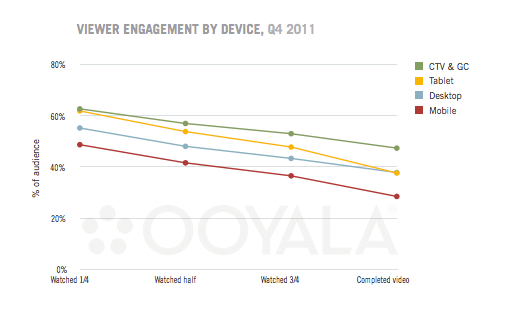From Redbox and Verizon teaming up to take on Netflix to Connected TV and Netflix’s premier of Lillyhammer, offering consumers video content where and when they want it is no longer just a second thought. Serving content across platforms has become essential for publishers and brands that want to grow their audiences and earn more revenue with online video.
Ooyala, the online video provider, today released its fourth quarter review of web video, in which it analyzes the viewing behavior of 100 million monthly unique users. (You can find the full report here.)
As we learned in Q3, the rabid adoption of mobile devices has been leading to increased engagement with online video. Not only that, but connected TVs are really beginning to make waves, Google TV in particular. Ooyala’s report found that video plays on tablets, mobile devices, and connected TVs nearly doubled in the fourth quarter (from Q3).
What’s more, viewers are now twice as likely to compete a video when watching on a tablet or connected TV, as compared to watching video on a desktop. And, unsurprisingly, when viewers plop down on their couch in front of their connected TV, they’re watching four times as many long videos compared to short videos, as videos longer than 10 minutes now account for more than half the hours played on connected TVs.
While the average conversion rate across all devices increased from 35.1 percent in Q3 to 39.6 percent in Q4 (with viewers watching longer on all platforms), it seems that connected TVs saw the biggest growth in Q4, as their viewers proved to be the most engaged of all the platforms, completing videos at a rate of 47 percent (with tablet viewers following close behind at 38 percent.)
What’s more, users of connected TV devices and gaming consoles were 70 percent more likely to watch three-quarters of a video. And, in terms of name brands in connected TVs, Google TV’s share of video plays increased by 91 percent this quarter.
Tablet viewers were the most engaged in Q3, and they certainly remained an attentive audience in Q4, proving to be 45 percent more likely to complete three-quarters of a video than those watching on a desktop. Not only that, but tablet viewers watched 21.9 percent longer per video in Q4 than the prior quarter.
Another interesting tidbit from Ooyala: Though this may not be particularly surprising, Facebook remains a much more active source of online video sharing than Twitter: For every video shared via Twitter in Q4, more than 10 were shared on Facebook.
Source: MobileCrunch





